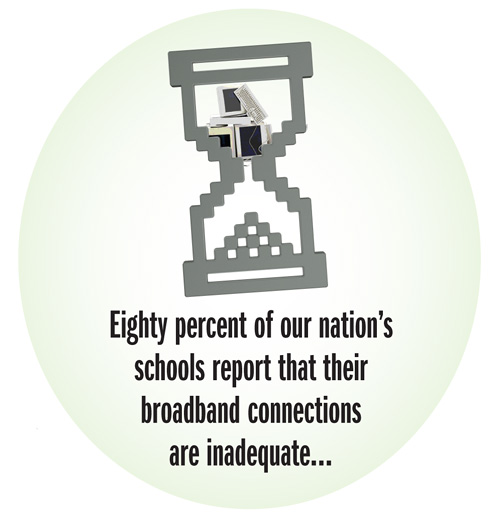
Evan Marwell wants to measure your pipes. The self-described serial entrepreneur is founder and CEO of Education SuperHighway, a nonprofit group whose goal is assessing the state of broadband in our nation’s schools. So is there enough juice to support 21st-century learning in most schools? Not by a long shot, says Marwell.
“We have to get the right infrastructure in place, and I realized no one knew what the state of that was,” he says. “In particular, they don’t know the actual experience students and teachers are having in the classroom.”
For Patty Eyer, that experience has been mixed. The media specialist at South Orangetown Middle School in Blauvelt, NY, says there are times of the day when students simply can’t access the Internet.
“The teachers are being asked to integrate tech into their classes,” she says, “and yet we don’t have enough computer labs and laptops. And even if we did, we don’t have the bandwidth. We have Internet, with [Ethernet] drops throughout the school. Are they 100 percent effective and efficient? No.”
That’s a familiar story to Marwell. Three years ago, after joining the board of his daughter’s school, Katherine Delmar Burke School in San Francisco, he questioned why classrooms didn’t have more technology. Marwell realized they simply lacked the necessary infrastructure.
It’s a pervasive problem. Eighty percent of our nation’s schools report that their broadband connections are inadequate to meet their needs, according to ‘The Broadband Imperative,” a May 2012 study by the State Educational Technology Directors Association (SETDA). Schools will need connections of 100 megabytes per second for every 1,000 students and staff by 2014–2015—and one gigabyte per second by 2017–2018, concludes SETDA.
Starting September 10, Marwell hopes to help schools—and, more critically, the U.S. Department of Education—get an accurate read on the situation. That’s the day that Education SuperHighway goes live—enabling students, teachers, administrators, librarians, and other school personnel to log on to the site and have their connection speed analyzed within minutes.
The money is there to upgrade schools’ technology, says Marwell, pointing to the E-rate program, a federal fund that spends $2.25 billion a year to provide telecommunication services to schools and libraries. “We need to refine [E-rate’s] goals, so it’s not just about connecting classrooms, but how they connect,” he says. “E-rate is certainly providing enough investment.”
Schools that plan to have their networks read on Education SuperHighway can also assess their ability to access specific sites, such as YouTube and Wikipedia, which require higher bandwidth. The project, which is funded by private investors and manned by five volunteers, plus Marwell, has a goal for each school in the country to run at least 10 tests—conducted by 10 different people or the same person 10 times—to give Marwell’s crew one million tests to assess.
With that information, Marwell says they’ll be able to inform a larger plan to determine the funding needed to properly wire every school.
“This isn’t a money problem, it’s an information problem,” he says. “We don’t know who has what and what needs to be fixed. But there’s definitely going to be money to do this.”


